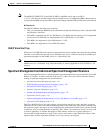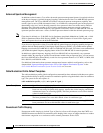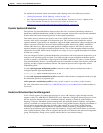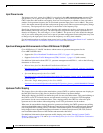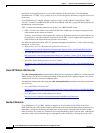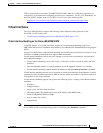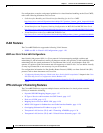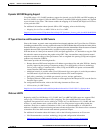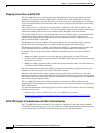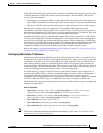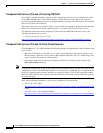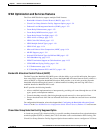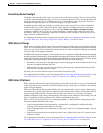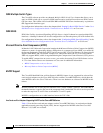
1-127
Cisco uBR7200 Series Universal Broadband Router Software Configuration Guide
OL-2239-05
Chapter1 Overview of Cisco uBR7200 Series Software
cops tcp window-size
Dynamic SID/VRF Mapping Support
Cisco IOS release 12.3(13a)BC introduces support for dynamic service ID (SID) and VRF mapping on
the Cisco CMTS, to support VoIP with MPLS. Formerly, the MPLS SID mapping feature only applied
to provisioned service flows. This feature enables the mapping of all PacketCable DQoS service flows
to one particular VRF.
For additional information about dynamic SID to VRF mapping, refer to the following:
• Mapping Service Flows to MPLS VPN on the Cisco CMTS
http://www.cisco.com/en/US/products/hw/cable/ps2217/products_feature_guide_book09186a008019b
6bd.html
IP Type-of-Service and Precedence for GRE Tunnels
Prior to this feature, at generic route encapsulation-based tunnel endpoints, the Type-of-Service (TOS) bits
(including precedence bits) were not copied to the tunnel or GRE IP header that encapsulates the inner packet.
Instead, those bits were set to zero. This was not a problem unless the intermediate routers between two tunnel
endpoints honored TOS or precedence bits, in which case those settings were ignored.
With the advent of virtual private network (VPN) and QoS applications, it is desirable to copy the TOS
bits when the router encapsulates the packets using GRE. Thus, intermediate routers between tunnel
endpoints can take advantage of the QoS features such as weighted fair queuing (WFQ) and weighted
random early detection (WRED).
This feature provides the following benefits:
• Routers between GRE tunnel endpoints will adhere to precedence bits and other TOS bits, thereby
possibly improving the routing of important packets. Cisco IOS Quality-of-Service technology,
such as policy routing, Committed Access Rate, WFQ, and WRED can operate on intermediate
routers between GRE tunnel endpoints.
• Additional security is possible when Cisco IOS network layer encryption is used with precedence
for GRE tunnels to provide data confidentiality between VPN tunnel endpoints.
• QoS policy granularity is available per network, per user, and per application.
• The deployment of a GRE tunnel is flexible; it can be applied at the Enterprise CPE or at the Service
Provider ingress point.
For configuration information, refer to the following document on CIsco.com:
• IP Precedence for GRE Tunnels
http://www.cisco.com/univercd/cc/td/doc/product/software/ios113ed/113t/113t_4/greqos.htm
IPv6 over L2VPN
Beginning with Cisco IOS Release 12.3(17a)BC, the Cisco uBR7246VXR router now supports IPv6
using Layer 2 VPNs based on SID to 802.1q mapping. The Cisco uBR7246VXR router already
supported Transparent LAN service with Layer 2 VPNs in Cisco IOS Release 12.3(13a)BC and later
releases. As more Internet users switch to IPv6, the Cisco IPv6 protocol support helps enable the
transition. IPv6 fixes a number of limitations in IPv4, such as limited numbers of available IPv4
addresses in addition to improved routing and network autoconfiguration. This feature allows customers
to introduce IPv6 into their network with minimal operational impact.
For additional information about this feature, refer to the following documents on Cisco.com:
• IPv6 Documentation: overview, technology, design and configuration information
http://www.cisco.com/en/US/tech/tk872/tsd_technology_support_protocol_home.html



